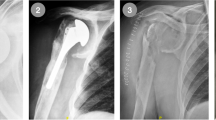Background. The purpose of the present work is to present treatment options and our own results for patients with infected shoulder alloarthroplasties.
Methods. Twelve patients with an infected shoulder replacement were treated. Their age ranged from 56 to 82 years. Indications for surgical revision were clinical symptoms compatible with an infection or positive serologic tests, especially an elevated C-reactive protein. Aspirated intra-articular fluid with a white blood cell count above 30,000 or positive for bacterial growth was also an important diagnostic feature. Retrospective analysis differentiated three groups with three different treatment regimens. Group 1 with early infection but without soft-tissue involvement (n=1): this particular patient underwent arthroscopic synovectomy. Group 2 with early infection and soft-tissue involvement within 4 weeks after index surgery (n=1): this patient underwent open synovectomy. The largest group was group 3 with late infection (n=10): these patients were treated with two-stage revision and a temporary spacer.
Results. The time between explantation and reimplantation ranged between 4 weeks and 6 months. With the temporary spacer, an anatomically stable condition could be established for all patients, and reconstruction of the humeral length even in long implants was possible. All patients underwent physiotherapy with the temporary spacer in place. A positive intraoperative microbiologic specimen was only found in 4 patients. In both group 1 and 2 patients, the infection healed, and thus the original implant could be kept in situ. In 8 patients, the temporary spacer was removed and exchanged for a regular implant. The postoperative raw Constant score at the time of the last follow-up examination was 48, due mainly to a loss of motion and power. All shoulders were stable, and the elbow function was good.
Conclusion. Use of an antibiotic-loaded spacer allows sucessful treatment of infected shoulder replacements.
Similar content being viewed by others
Author information
Authors and Affiliations
Additional information
Electronic Publication
Rights and permissions
About this article
Cite this article
Jerosch, J., Schneppenheim, M. Management of infected shoulder replacement. Arch Orthop Trauma Surg 123, 209–214 (2003). https://doi.org/10.1007/s00402-003-0497-9
Received:
Issue Date:
DOI: https://doi.org/10.1007/s00402-003-0497-9




